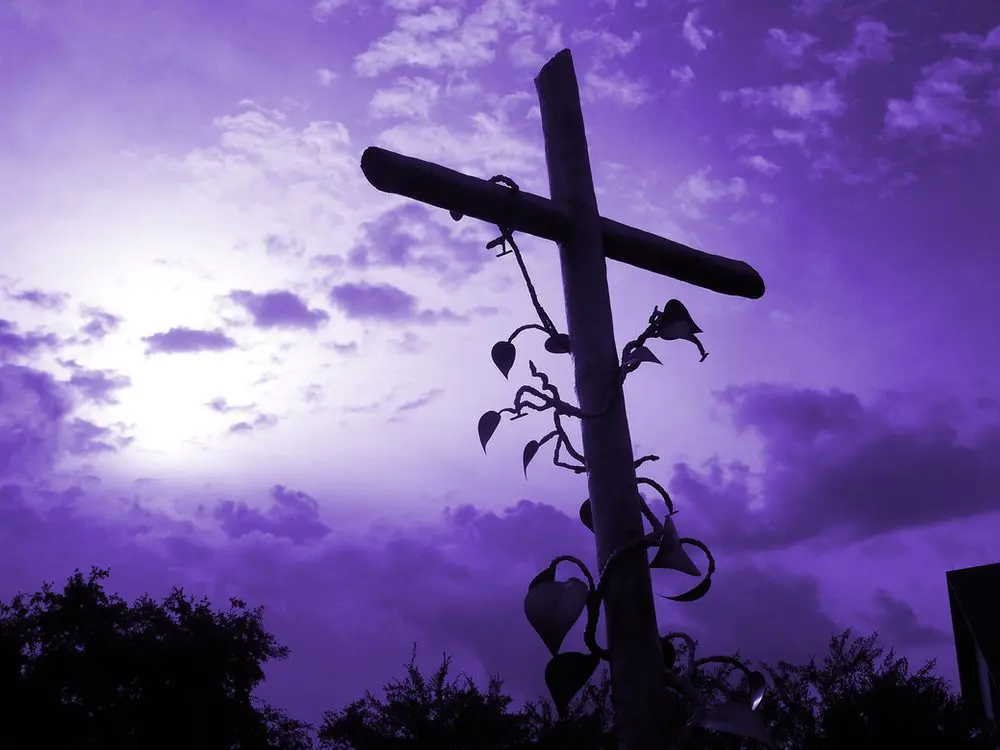The Death of the King

In the first century, Rome executed criminals by crucifixion. It was a humiliating and agonizing experience. There was no concept of death with dignity for the guilty. According to “Roman Antiquities”, after a man was sentenced to die, he was stripped of his clothes and paraded through the streets of the city, so that his punishment would be seen by all. He was required to carry a 50 pound cross-piece, (or sometimes the entire cross, which weighed about 200 pounds) and as he stumbled toward his execution, the soldiers would follow closely behind, whipping him along the way.
When they arrived at the place of execution, the criminal would be both nailed and tied by rope to the crossbeam, and then would be lifted onto the cross. One minor inaccuracy we see in films and paintings of the crucifixion scene is that the cross didn’t tower high above the crowd. Part of the point of the point of the crucifixion was that the criminal should experience the torment of dangling just above the ground, and his tormentors could easily look him in the face.
The position in which the condemned man hung made it difficult for him to exhale. That’s why his legs were bent and his feet nailed near the base of the cross—so he could push his torso a few inches and gasp for breath until the pain in his legs became unbearable and he collapsed again. The process was slow and agonizing. Sometimes the one crucified died because of shock or dehydration, but most often it was because he lost the ability to support his weight and therefore suffocated. However, it didn’t happen quickly; it was not uncommon for death to take two days. Whenever the authorities decided (for whatever reason) to expedite the criminal’s death, his legs would be broken so that he could no longer push himself up for breath, and he would suffocate within a matter of minutes.

Throughout the history of the Roman Empire, untold thousands were executed in this fashion. As enlightened as their society might have been they certainly placed little value on human life—especially the life of one obscure Jewish peasant from Galilee. After Pilate sentenced Jesus to die, he turned him over to the soldiers, whose job was to lead him to his execution. The soldiers mocked him with words such as “Hail! King of the Jews!” The beat him and spit on him and placed a crown of thorns upon his head.
(v 20) When they were finally tired of mocking him, they took off the purple robe and put his own clothes on him again. Then they led him away to be crucified.
Today, I want us to look at three spiritual truths that are found in the story of Christ’s crucifixion; three lessons for Meditation that will help us experience his healing presence in our lives. First…
1. Jesus couldn’t carry his own cross…
Since Mosaic Law required that executions be made outside the city, the Romans accommodated this custom and criminals were put to death on a hill outside of Jerusalem. Roman custom was to position places of execution near well-traveled roads so that people could easily see what became of those who opposed Caesar.
It was now time for Jesus to begin to the journey to his death. Last week we talked about the type of physical punishment that Jesus had already endured up to this point—the scourging of the Roman whip—so it is not surprising that he physically could not carry his cross.
(v. 21) A man named Simon, who was from Cyrene, was coming in from the country just then, and they forced him to carry Jesus’ cross. (Simon is the father of Alexander and Rufus.)

Cyrene was a Greek settlement on the North African coast of the Mediterranean, in what is now modern Libya. It had a large Jewish population, and since “Simon” is a common Jewish name, he had probably come to Jerusalem as a pilgrim to celebrate the Passover. The Bible says he was just a passer-by when he was recruited by the Roman soldiers to carry Jesus’ cross for him. Most likely it was against his will—Roman soldiers had the authority to demand such things, and since he was able-bodied, he could not refuse. Mark includes an additional detail about this man…
(v 21) (Simon is the father of Alexander and Rufus.)
Since Mark believed his early readers would know who Alexander and Rufus are, most probably they were believers active in the church in Rome, where Mark wrote his gospel. The apostle Paul also mentions a Roman Christian named Rufus (Romans 16:13), and this could be the same person Mark refers to. As this man—Simon of Cyrene—was pulled out of the crowd and compelled to carry the cross of a convicted criminal, he might have seen something in Jesus that caused him to want to know more about him, and ultimately he became a follower.
Jesus couldn’t carry his own cross, and so this unknown man—a man just like you and me—had to carry it for him. This is ironic, but one of the most important lessons of the crucifixion is that even though Jesus couldn’t carry his own cross…
… but he is the only one who can help you carry yours.
Do you know what it is to have more on your shoulders than you can possibly bear? Do you know what it is to feel absolutely helpless? Absolutely powerless? Jesus does. Through most of the Passion story we see him standing strong and bold and courageous in the face of the worst kind of abuse. And now, with the end so near, his body completely gives out. He cannot take another step in his own strength.
When you come to the place in your life when you cannot take another step on your own strength, I want you to know that Jesus has been there, too. Remember the verse from Hebrews…
This High Priest of ours understands our weaknesses, for he faced all of the same temptations we do, yet he did not sin. (Hebrews 4:15)
Whatever the cross you have to bear in life—illness, weakness, trials, temptations, mistreatment—whatever it may be, you don’t have to bear the burden alone. Jesus will help you carry your cross. Earlier in his ministry, he spoke these words…
“Come to me, all of you who are weary and carry heavy burdens, and I will give you rest. Take my yoke upon you. Let me teach you, because I am humble and gentle, and you will find rest for your souls. For my yoke fits perfectly, and the burden I give you is light.” (Matthew 11:28-30)
Jesus came into this world to identify with the human race, to experience all that we experience–the same challenges, the same temptations, the same desperation. He understands you. He knows what it is like not to be able to go on, and he will be there to give you strength in your time of need.
The second lesson in the crucifixion story is…
2. Jesus could not save himself…
(v. 22-23) And they brought Jesus to a place called Golgotha (which means Skull Hill). They offered him wine drugged with myrrh, but he refused it.
There’s some scholarly speculation about what the wine drugged with myrrh was intended to do. It might have been a drug intended to deaden his pain. It might have been a poison intended to expedite his death. Either way, Jesus didn’t accept the offer. He had been destined to “drink the cup” of his sacrificial death, and he intended to remain fully conscious until the bitter end.
(v. 24-32) Then they nailed him to the cross. They gambled for his clothes, throwing dice, to decide who would get them. It was nine o’clock in the morning when the crucifixion took place. A signboard was fastened to the cross above Jesus’ head, announcing the charge against him. It read: “The King of the Jews.” Two criminals were crucified with him, their crosses on either side of his. And the people passing by shouted abuse, shaking their heads in mockery. “Ha! Look at you now!” they yelled at him. “You can destroy the Temple and rebuild it in three days, can you? Well then, save yourself and come down from the cross!” The leading priests and teachers of religious law also mocked Jesus. “He saved others,” they scoffed, “but he can’t save himself! Let this Messiah, this king of Israel, come down from the cross so we can see it and believe him!”
Often, executed criminals were the subjects of taunts and derision from a crowd of spectators. There’s something in human nature that causes some to want to gloat about the punishment of others, doing everything possible to add to their agony.
We see this even today. When a person is executed by the state there are always two groups gathered outside the prison walls: an anti-death penalty group holding a candlelight vigil, and another group of people who are not merely pro-death penalty, but who have gathered specifically to celebrate the execution of the criminal. They often carry signs that say things like “Burn in hell, so-and-so” and “We hope you suffer like your victims” and so on. I don’t want to get off track here into a debate about the merits of the death penalty, but I’ll say this: most people who support the death penalty do not support the festive atmosphere that takes place at executions. I can’t imagine considering such an event an evening’s Entertainment.
In first century Jerusalem, there were some who considered crucifixions that very thing. When a man was condemned to die, they would follow the procession out of town to the hill called Golgotha and entertain themselves at the dying man’s expense.’’
As Jesus hung on the cross, stripped, beaten and bloody, he must have been an easy target for ridicule. They taunt him as the one who supposedly had claimed he could destroy and rebuild the temple in three days; watching him die helpless and alone must have made his claim seem laughable.
Some of the leading priests were also there, saying, “Let this Messiah come down off the cross so that we can see it and believe in him.” Of course, we know now that Jesus could have done that. He could have saved himself, just as he could have prevented himself from being there. He was there, not because he was the victim of circumstances beyond his control, but because he chose to lay down his life for the sake of the world. Earlier he had said to his disciples…

I am the good shepherd. The good shepherd lays down his life for the sheep…I lay down my life that I may have it back again. No one can take my life from me. I lay down my life voluntarily. For I have the right to lay it down when I want to and also the power to take it again. (John 10:11, 17-18)
As Jesus was arrested, he said to his disciples…
Don’t you realize that I could ask my Father for thousands of angels to protect us, and he would send them instantly? But if I did, how would the Scriptures be fulfilled that describe what must happen now?” (Matthew 26:53)
In that sense, Jesus could have saved himself. But there is another sense in which he couldn’t save himself. This is an important lesson in the crucifixion. Jesus could not save himself…
… because he wanted to save you.
Saving you—forgiving your sins and giving you eternal life—meant that he had to die on the cross to pay the price for your sins, and he was willing to do it. He was willing to die so that you can live. He was willing to die so that you—and everyone who chooses to believe in him—could be reconciled to God. Paul said…
All this newness of life is from God, who brought us back to himself through what Christ did…For God was in Christ, reconciling the world to himself, no longer counting people’s sins against them…For God made Christ, who never sinned, to be the offering for our sin, so that we could be made right with God through Christ. (2 Corinthians 5:18, 19, 21)
Jesus died on the cross because that’s what it took to bring about our reconciliation, and that was a price he was willing to pay. In the Garden of Gethsemane he had prayed, “If it is possible, take this cup from me” — but it was not possible. He had to go to the cross. So, despite all the power available to him, he couldn’t save himself, because he wanted to save you. It wasn’t the nails that bound him to that tree; his love for you held him there.
There’s a third lesson in the crucifixion that I want us to consider.
3. Jesus experienced separation from God…
(v. 33) At noon, darkness fell across the whole land until three o’clock. 34Then, at that time Jesus called out with a loud voice, “Eloi, Eloi, lema sabachthani?” which means, “My God, my God, why have you forsaken me?”
This is the most difficult part of the story for me to tell. It’s also the part that Mel Gibson couldn’t capture on film. We saw Christ’s anguish in the garden, the injustice he suffered at the hand of Pontius Pilate, the mistreatment he endured from the Roman soldiers. These scenes were all heartbreaking. But this scene is beyond our ability to understand. At this precise moment, the Son of God’s own Father abandons him, because at this precise moment, the words spoken in Isaiah have become true…
The Lord laid on him the guilt and sins of us all. (Isaiah 53:6)
As I read earlier from Paul…
For God made Christ, who never sinned, to be the offering for our sin, so that we could be made right with God through Christ. (2 Corinthians 5:21)
In that one horrifying moment, Jesus experienced separation from God…
…so that you can experience reconciliation with God.
Jesus cried, “My God, My God, why have you forsaken me?” so that you will never have to cry those words. Here is the heart of the gospel—the reason for it all. We can be reconciled to God, we can be in a right relationship with him, we can be forgiven of our sins and receive everlasting life… through the sacrificial death of Jesus Christ. Listen to the words of Paul…
But now God has shown us a different way of being right in his sight–not by obeying the law by the way promised in the Scriptures long ago. We are made right in God’s sight when we trust in Jesus Christ to take away our sins. And we all can be saved in this same way, no matter who we are or what we have done. (Romans 2:21-22)
CONCLUSION
A comment I have heard from many who have seen the Passion movie is that it gives a person greater understanding of what Christ did for us. That’s true. The movie tells us what Christ did for us, but it doesn’t really tell us why. It shows us his sufferings, but it doesn’t explain them to us. I doubt that any movie could, but the Bible can. The Bible says…
He personally carried away our sins in his own body on the cross so we can be dead to sin and live for what is right. You have been healed by his wounds! (1 Peter 2:24)
Peter is quoting a verse from Isaiah. We read it earlier in this series; it’s the verse that appears on the screen as the movie begins…
He was pierced for our transgressions, he was crushed for our iniquities; the punishment that brought us peace was upon him, and by his wounds we are healed. (Isaiah 53:5 NIV)

The passion of Christ—his suffering and death—is our healing and our salvation. Through his wounds, we can experience the healing of our wounds. So I encourage you to meditate on the Passion of Christ.
Remember the garden. He was all alone in his agony, but you are not alone in yours. When you face your Gethsemane, he is there with you, and through praying a “Gethsemane” prayer, you will experience power over temptation.
Remember his trial. He was declared guilty of crimes he did not commit and received a death sentence he did not deserve, but he endured man’s injustice so that you won’t have to face God’s justice for your sins–you can instead experience God’s mercy.
Remember his crucifixion. He could not save himself, because he wanted to save you. He experienced separation from God so that you can experience reconciliation to God.
Moments before Jesus died, he cried…
“It is finished.” (John 19:30)
And then he said…
“Father, into your hands I commend my spirit.” (Luke 23:46)
Though his work is finished on the cross, his work is not finished in you. He wants you to experience the fullness of a relationship with him. He longs for you to be filled with his spirit. He wants you to experience the power of his resurrection. That is why he gave his life for you.
Originally Published on https://www.becomingbridgebuilders.org/blog
























